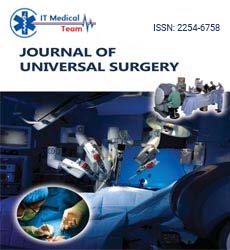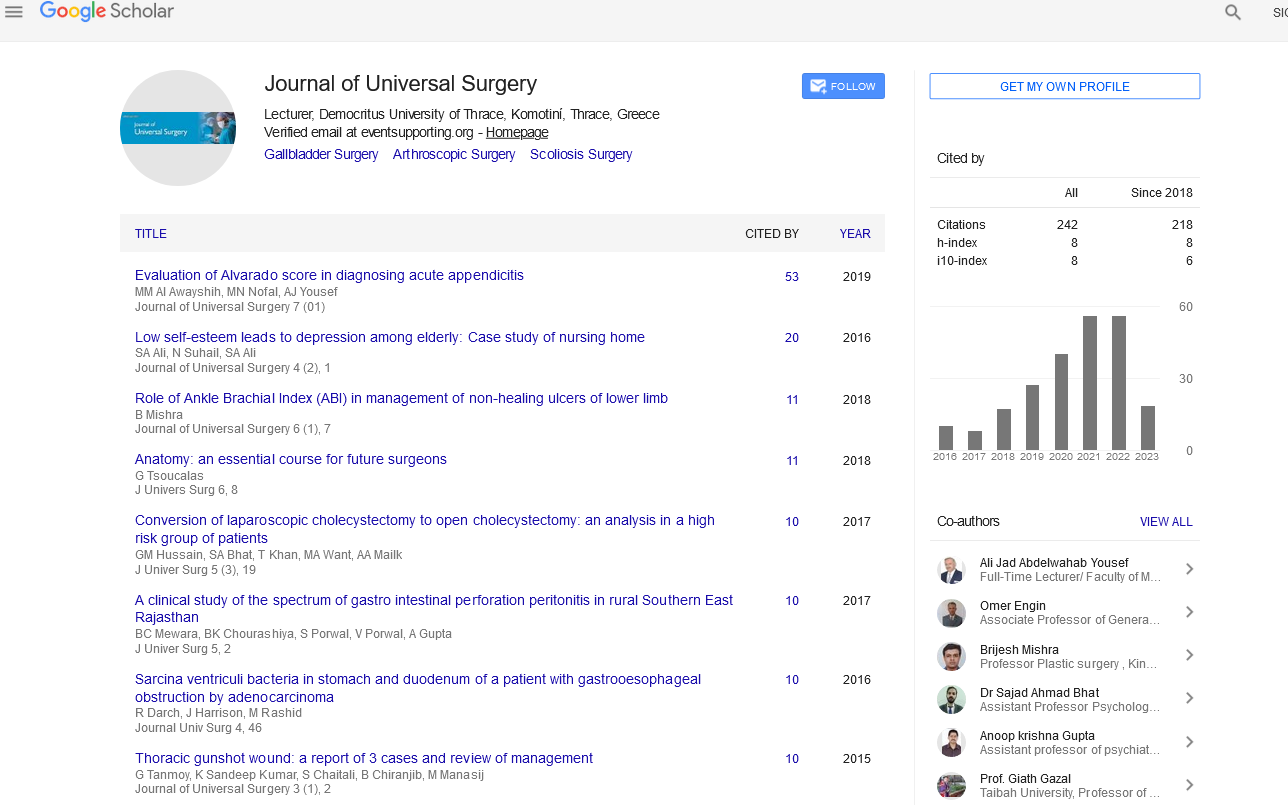Review Article - (2023) Volume 11, Issue 1
OSAS Surgery and Postoperative Inconvenience: Stage I Surgery versus Stage II Surgery
Gasparini Giulio*
Maxillo Facial Surgery, School of Medicine, Catholic University of Sacred Heart, Italy
*Correspondence:
Gasparini Giulio, Maxillo Facial Surgery, School of Medicine, Catholic University of Sacred Heart,
Italy,
Email:
Received: 01-Jan-2023, Manuscript No. IPJUS-23-13413;
Editor assigned: 03-Jan-2023, Pre QC No. IPJUS-23-13413 (PQ);
Reviewed: 17-Jan-2023, QC No. IPJUS-23-13413;
Revised: 24-Jan-2023, Manuscript No. IPJUS-23-13413 (R);
Published:
31-Jan-2023, DOI: 10.36648/2254- 6758.23.11.01.87
Abstract
This think about points to examine the reasons that debilitate the patients influenced by OSAS to experience orthognathic surgery and compares the postoperative distress of stage I (delicate tissue surgery) and stage II (orthognathic surgery) methods for treatment of OSAS. Fabric and Strategies . A pool of 46 patients influenced by OSAS was partitioned into two bunches: “surgery patients” who acknowledged surgical medications of their condition and “no surgery patients” who denied surgical methods. The “surgery patients” bunch was assist subdivided into two arms: patients who acknowledged stage I methods (IP) and those who acknowledged stage II (IIP). To way better get it the inspirations behind the refusal of II stage strategies, we inquired the patients having a place to both the IP gather and “no surgery” gather to show the most reason that impacted their choice to maintain a strategic distance from II stage methods. We moreover checked and compared five parameters of postoperative distress: torment, painkiller presumption.
Keywords
Surgical; Painkiller; Edema; Apnea; Distress
INTRODUCTION
Surgical methods to treat Obstructive Rest Apnea Disorder (OSAS) point either to debulk the delicate tissues or to extend the skeletal outline; the previous strategies point to reduce/ remove the obstacles due to the intemperate bulk of delicate tissues lining the rhinoorohypopharynx and may be performed as single or combined methods, depending on understanding exigencies. Surgical strategies on delicate tissue are for the most part characterized as “First Stage Interventions” (IP) and point to debulk delicate tissues whereas keeping up the same skeletal volume. When IP strategies fall flat in getting palatable comes about, “Second Stage Interventions” (IIP) of orthognathic surgery are performed in arrange to extend the skeletal volume of the pharynx and extending the delicate tissues, creating, as last result, an viable extension of the discuss column. There is common agreement in writing that the foremost compelling and solid intercessions are the IIP in any case, as shown by the classification [1, 2].
Discussion
Forty-six patients influenced by OSAS of different degrees have been seen in our clinic between January 1, 2008, and December 31, 2012. The test included 26 guys (56.5%); the cruel age was 44 a long time (extend 18–82, Standard Deviation (SD): 16). Thirtyseven patients (80.4%) endured from course II dentoskeletal mutation and 8 had lesson III distortion (17%), whereas two patients (3%) had dentoskeletal course I with bimaxillary retrusion appeared at the cephalometric investigation. The cruel Apnea- Hypopnea Record (AHI) of the bunch was 29.4 (SD: 12), and the cruel Body Mass File (BMI) was 33.4 (SD: 5). All the patients were alluded by neurology, otolaryngology, inside medication, and pneumology pros and were influenced by OSAS with an fundamental dentoskeletal mutation requiring surgical redress. All the patients experienced clinical appraisal, teleradiography of noggin in two projections, CT filter of noggin without differentiate, cephalometric examination, and endoscopic evaluation [3].
We choose to compare a few parameters of postoperative distress that were common to both the IP and IIP strategies, they included torment, painkiller require, affirmation days, remote body sensation within the throat, and typical count calories intake. All parameters were recorded from the primary postoperative day. None of the patients endured from nourishment intolerances or medicate hypersensitivities. The postoperative medicines were the same for all the patients and included amoxicillin/clavulanic corrosive 2.2 gr i.v. each 12 hours and acetaminophen 1 gr i.v. on the off chance that needed. A Visual Analogic Scale (VAS) was utilized to objectivize the torment level, being 10 the esteem comparing to most extreme torment and 1 the condition of “no pain”. To assess the parameter “need of painkiller," the amount of acetaminophen communicated in required dosages was recorded and compared. For the assessment of the “foreign body sensation,” we moreover utilized a VAS relegating the esteem 10 to most extreme outside body feeling and 1 as typical feeling [4].
The parameter “diet” involved three degrees: ordinary eat less, semisolid count calories, and obligatory fluid diet. To analyze the contrast of postoperative distress between patients who experienced IP strategies and those who experienced IIP methods, we separated the test into two bunches on one side we pooled all the patients that acknowledged the surgical treatment either IP or IIP and characterized that bunch as “Surgery Patients” (SP); the bunch “No Surgery Patients” (NSP) included all patients who denied surgery. The SP gather was assist subdivided into patients who acknowledged IIP methods and those who concurred only on IP procedures. The SP gather included 28 patients; cruel age was 39 a long time (SD: 11). Guys were 17 (60.7% of the test). Nine patients (32.1%) experienced I stage intercessions. Among these 9 patients, 9 (100% of I stage gather patients) experienced uvulopharyngopalatoplasty, 7 (77.8%) decongestion of turbinates and septoplasty, and 2 patients (22.2%) thyrohyoidpexy mediation [5, 6].
To explore the reason for denying IIP strategies, we asked all members having a place to NSP and IP methods to show what was the bunch of postoperative inconvenience that impacted their choice, choosing between “Group A” and “Group B.” In the NSP gather (18 patients, 39% of the test), 5 were stressed of postoperative distresses having a place to “Group A” and 6 patients were debilitated by “Group B” distresses, whereas 8 patients denied surgery for stresses related to both “Group A” and “Group B” discomforts. Among the 9 patients who acknowledged as it were IP methods, 6 patients denied IIP surgery since of “Group A” distresses and 2 were concerned approximately “Group B” inconvenience, whereas one understanding demonstrated both “Group A” and “Group B” inspirations. The connection between corpulence and hypoventilation was to begin with portrayed within the late 1950’s when weight, hypopnea, and expanded dangers of heart illnesses were emphatically related by a few ponders [7, 8].
Conclusion
The surgical methods proposed to treat OSAS were either coordinated solely to the delicate tissues of the nose, rhino-, oro, and Hypo Pharynx (IP) or pointed at changing the position of the Skeletal Bases (IIP); as a rule IIP strategies were shown after disappointment of IP intercessions. These days the foremost well known surgical treatment for OSAS is IP procedures, indeed in spite of the fact that there's consistent understanding that IIP surgery gives superior and more reliable results. This ponder appeared that the most reason debilitating the patients to acknowledge IIP surgery was the concern of postoperative distresses. Comparison of the parameter “postoperative pain” between patients who experienced IP procedures and those who had IIP surgery appeared higher torment within the previous bunch; quiet treated with IP surgery detailed serious torment for the primary two postoperative weeks that was still display 30 days after surgery. The torment taking after IP surgery was ordinarily sharp in nature, found at the throat [9, 10].
Acknowledgement
None
Conflict of Interest
None
References
- Pahor AL (1992) Ear, nose and throat in ancient Egypt. J Lar Otol Lond 106: 677-687.
Google Scholar, Crossref, Indexed at
- Sullivan R (1996) the identity and work of the ancient Egyptian surgeon. J R Soc Med 89: 467-473.
Google Scholar, Crossref, Indexed at
- Ruetsch YA, Böni T, Borgeat A (2001) from cocaine to ropivacaine: the history of local anesthetic drugs. Curr Top Med Chem 1: 175-182.
Google Scholar, Crossref, Indexed at
- Brill S, Gurman GM, Fisher A (2003) A history of neuraxial administration of local analgesics and opioids. European Journal of Anaesthesiology 20: 682-689.
Google Scholar, Crossref, Indexed at
- Reddy S, Patt RB (1994) the benzodiazepines as adjuvant analgesics. J Pain Symptom Manag 9: 510-514.
Google Scholar, Crossref, Indexed at
- Mallinson T (2019) Fascia iliaca compartment block: a short how-to guide. J Paramed Pract 11: 154-155.
Google Scholar, Crossref
- Lewis Sharon R, Price Anastasia, Walker Kevin J, McGrattan Ken, Smith Andrew F, et al. (2015) Ultrasound guidance for upper and lower limb blocks. Cochrane Database Syst Rev (9): 6459.
Google Scholar, Crossref, Indexed at
- Ullah H, Samad K, Khan FA (2014) Continuous interscalene brachial plexus block versus parenteral analgesia for postoperative pain relief after major shoulder surgery. CDSR (2): 7080.
Google Scholar, Crossref, Indexed at
- Klomp T, Van Poppel M, Jones L, Lazet J, Di Nisio M, et al. (2012) Inhaled analgesia for pain management in labour. CDSR 12: 9351.
Google Scholar, Crossref, Indexed at
- Radvansky BM, Shah K, Parikh A, Sifonios AN, Eloy JD, et al. (2015) Role of ketamine in acute postoperative pain management: a narrative review. BioMed Research International.
Google Scholar, Crossref, Indexed at
Citation: Giulio G (2023) OSAS Surgery
and Postoperative Inconvenience: Stage I
Surgery Versus Stage II Surgery. J Uni Sur,
Vol. 11 No. 1: 103.





